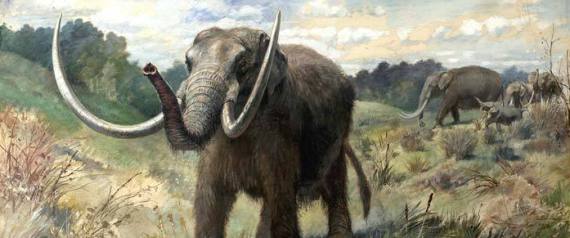Wednesday December 3rd, 2014
link to article below
Maybe Humans
Didn't
Drive Mastodons To
Extinction
The Huffington Post | By Jacqueline Howard
Posted: Updated:

Maybe humans weren't to blame for the demise of the American mastodon after all.
For years, conventional wisdom held that mastodons were hunted to extinction in North America some 10,000 years ago. But a new study echoes previous researchindicating that mastodons and most of the other big animals that once lived on the continent, known as megafauna, may have already died out before humans migrated to North America from Asia.
"We're not saying that humans were uninvolved in the megafauna's last stand 10,000 years ago. But by that time, whatever the mastodon population was down to, their range had shrunken mostly to the Great Lakes region," study co-author Dr. Ross MacPhee, a curator in the mammalogy department at the American Museum of Natural History in New York City, said in a written statement. "That's a very different scenario from saying the human depredations caused universal loss of mastodons across their entire range within the space of a few hundred years, which is the conventional view."
For the study, which was published online in the Proceedings of the National Academy of Sciences on December 1, 2014, the researchers used two types of radiocarbon dating on 36 fossilized mastodon teeth and bones that had been unearthed in Alaska and the Yukon.
What did the research reveal about North America's mastodons?
"We learned that they weren't even here by the time people showed up," Dr. Grant Zazula, a paleontologist with Canada's Yukon Palaeontology Program and the study's lead author, told CBC News.
In fact, the fossils are far older than previously thought, with most surpassing 50,000 years old. And archaeologists estimate that humans started moving to North America no earlier than about 25,000 years ago.

Zazula cutting samples of American mastodon bones for radiocarbon dating.
"There was a massive [mastodon] die-off of a good part of their population in the northern part of the continent around 75,000 years ago," Zazula told the Los Angeles Times. "We suspect that once the northern group died off, the species was already heading toward trouble... What ultimately pushed them over the edge, though--hunters picking off the last of them or climate change at the end of the ice age being just too much for them--is an unanswered question. There isn't a smoking gun."











No comments:
Post a Comment